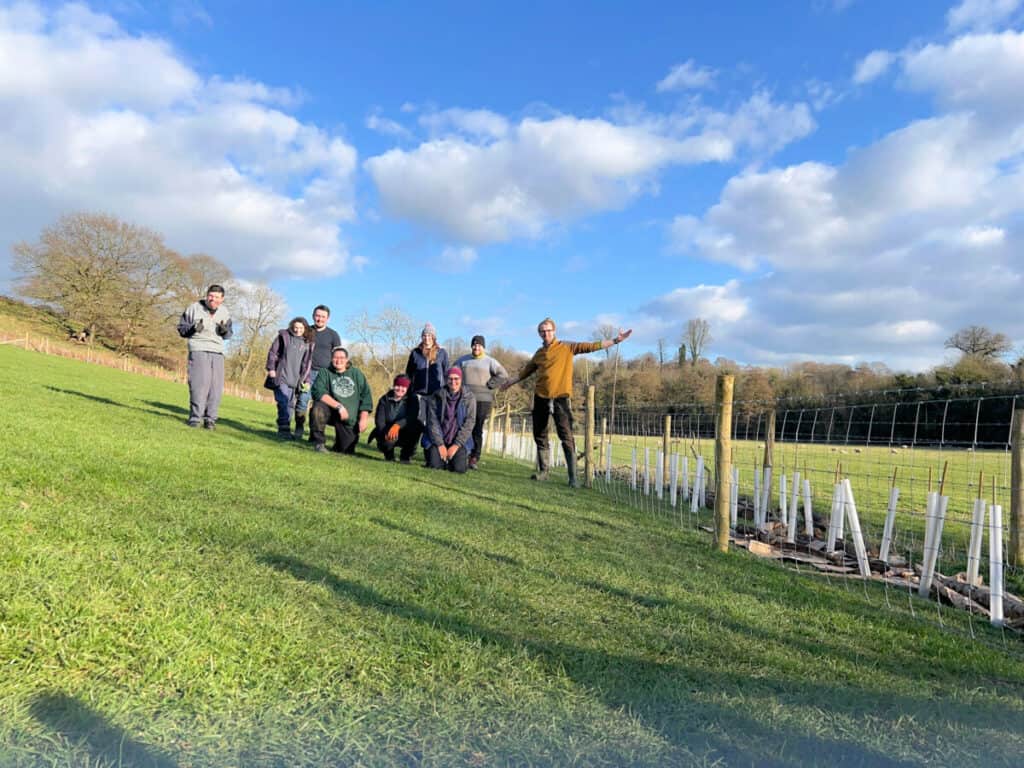In the last Grazer, we shared Charlotte and Ben’s journey into silvopasture, which is the practice of integrating trees into the livestock farming system in a mutually beneficial way. For us, this could mean they act as ‘living barns’ during harsh weather, as forage to provide additional nutrition to that found in the pasture, or that they provide a handy medicine cabinet for the livestock to access as they need it. These grazed woodland areas not only provide huge benefits for livestock, but by creating new habitats and linking existing ones, we are also benefiting huge numbers of insects and wildlife. What could be better?
This February, our volunteers have been busy planting a new tree line at Fordhall. Over 150 metres of hazel, willow, aspen, walnut and Shropshire prune, will link trees around our heritage site (Ringwork and Bailey), with trees around our spring-fed pool. As trees for silvopasture have so many uses, choosing the right trees has been crucial. Here we share some of the reasons why.
Why Hazel?
Well, where do we start? Apart from it being wonderfully native, beautiful and easy to grow, it is easily coppiced for walking sticks, hurdle making and more. The nuts taste delicious and are highly nutritious; boasting high levels of vitamin E and B vitamins. They are high in antioxidants and, due to their energizing effects, they are also great for diabetics – although hopefully none of our cows are diabetic!
Certain compounds in hazelnuts (taxanes) have anticancer effects. According to the Woodland Trust, the active principles of the leaves have vasoconstrictor, antibacterial, anti-inflammatory, anti-edematous and healing properties. The oil extracted from the seeds has emollient, hypotensive, anti-anaemic (due to its high mineral content of nitrates, phosphorus, potassium and iron), and anthelmintic properties (against tapeworm). This means the leaves could help with liver, kidney and lung conditions too!
So that covers us and the livestock, but what about nature? Hazelnuts are, of course, full of calories and perfect for a tasty lunch before hibernation for squirrels, dormice and the like. Then in spring, the leaves are a good source of caterpillars, which dormice can eat as they come out of hibernation.
Hazel leaves provide food for the caterpillars of moths, including the large emerald, small white wave, barred umber and nut-tree tussock. Where hazel is coppiced, or grazed overhead by livestock, the open, wildflower-rich habitat supports species of butterfly, particularly fritillaries. Coppiced hazel also provides shelter for ground-nesting birds such as the nightingale, nightjar, yellowhammer and willow warbler.
Furthermore, the trunks are often covered in mosses, liverworts and lichens, and the fiery milkcap fungus grows in the soil beneath.
And if that wasn’t enough, hazel has a reputation as a magical tree. A hazel rod is supposed to protect against evil spirits, as well as being used as a wand and for water-divining.
What is not to like?
If you would like to sponsor a hazel tree at Fordhall then a donation of £10 will plant and support a new tree.
Why Willow?
All willows are fast growing; in fact, they are some of the fastest growing trees in the world – that means they can absorb lots of carbon from the atmosphere in the process. They love damp ground and can withstand lots of pruning or grazing. They also contain tannins, which can help cows digest their food more effectively, and have anthelmintic (deworming/antiparasitic) effects. Willow trees contain cellulose, which can provide some roughage for cows’ diets; perfect for during the winter months. The essence of the bark is effective against flukes and diarrhoea in sheep. It is also high in iron and phosphorus, promoting a healthy digestion in all who consume it.
Some farmers have said that willow leaves and small stems (less than 10mm) are even superior to summer pasture.
Willow bark is the original source of aspirin, and for centuries the bark has been used to relieve pain in humans due to its rich blend of antioxidants and organic compounds. But it is not just medicine that humans and animals use the mighty willow for. The branches are also used in the manufacture of baskets, fishing nets, furniture and toys.
Nature is not short-changed either. Willow is said to be second to oak in the number of different wildlife species a mature tree can sustain. According to the Woodland Trust, male trees provide pollen for bees in early spring when the catkins are out and bee food is scarce. Caterpillars of a number of moth species feed on white willow leaves, including the puss moth, willow ermine, eyed hawk-moth and red underwing. Goat willow foliage is eaten by the caterpillars of many moths too, including the sallow kitten, sallow clearwing, dusky clearwing and lunar hornet clearwing. It is also the main food plant for the purple emperor butterfly. As a result, birds use goat willow to forage for caterpillars and insects, as well as using the high branches for nesting sites.
They are not without their folklore either. All willows were seen as trees of celebration in biblical times, and in China willow remains a symbol of immortality and rebirth. Whereas in other parts of the world willow often represents grief and sadness. Willow trees are related to mysticism and superstition too. According to legend, witches crafted brooms using the branches of the willow tree, helping them to fly to other worlds. We are not too sure about that one!
If you would like to sponsor a willow tree at Fordhall then a donation of £15 will plant and support a tree in our new scheme.
This article was first featured in the Spring 2023 edition of the Grazer magazine. For more info and to subscribe, visit:
FCLI Shares,The Grazer,Calendars,Tickets & Books – Fordhall Farm


